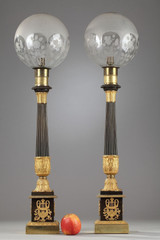A pair of Carcel lamps in bronze and glass from the Restoration period. The partially patinated and fluted stem is adorned with chased and gilded bronze acanthus leaves. It rests on a small foliate base and a square plinth decorated with alternating crowns and lyres with swan heads holding garlands. A wide frieze of heart-shaped motifs borders the plinth. The frosted glass globes are engraved with floral designs. This lamp model was invented in 1800 by Guillaume Carcel (1750-1812), a clockmaker in Paris. The Carcel lamp—for which its inventor received a prize from the Academy of Sciences in 1854—features a clockwork mechanism to raise the oil. Its mechanism consists of a pump powered by a spring-driven motor that is wound with a key. This mechanism, located at the base of the lamp, allowed the oil in the reservoir to be constantly raised to the wick. This continuous flow of liquid had several advantages: firstly, it prevented the wick from charring and going out; secondly, it prevented the oil from overheating and vaporizing; and finally, with the new system, the lamps no longer emitted smoke or unpleasant odors. The invention of the Carcel lamp marked a fundamental advance in the history of lighting and revolutionized the oil lamp. Restoration period, circa 1820. Dimensions: W: 21cm, D: 21cm, H: 82cm. In good overall condition, with some scratches, stains, and signs of age. They have been electrified and are in working order.
- Reference :
- 2043
- Availability :
- Sold
- Width :
- 21 (cm)
- Height :
- 82 (cm)
- Depth :
- 21 (cm)
- Identify Exists:
- False




















